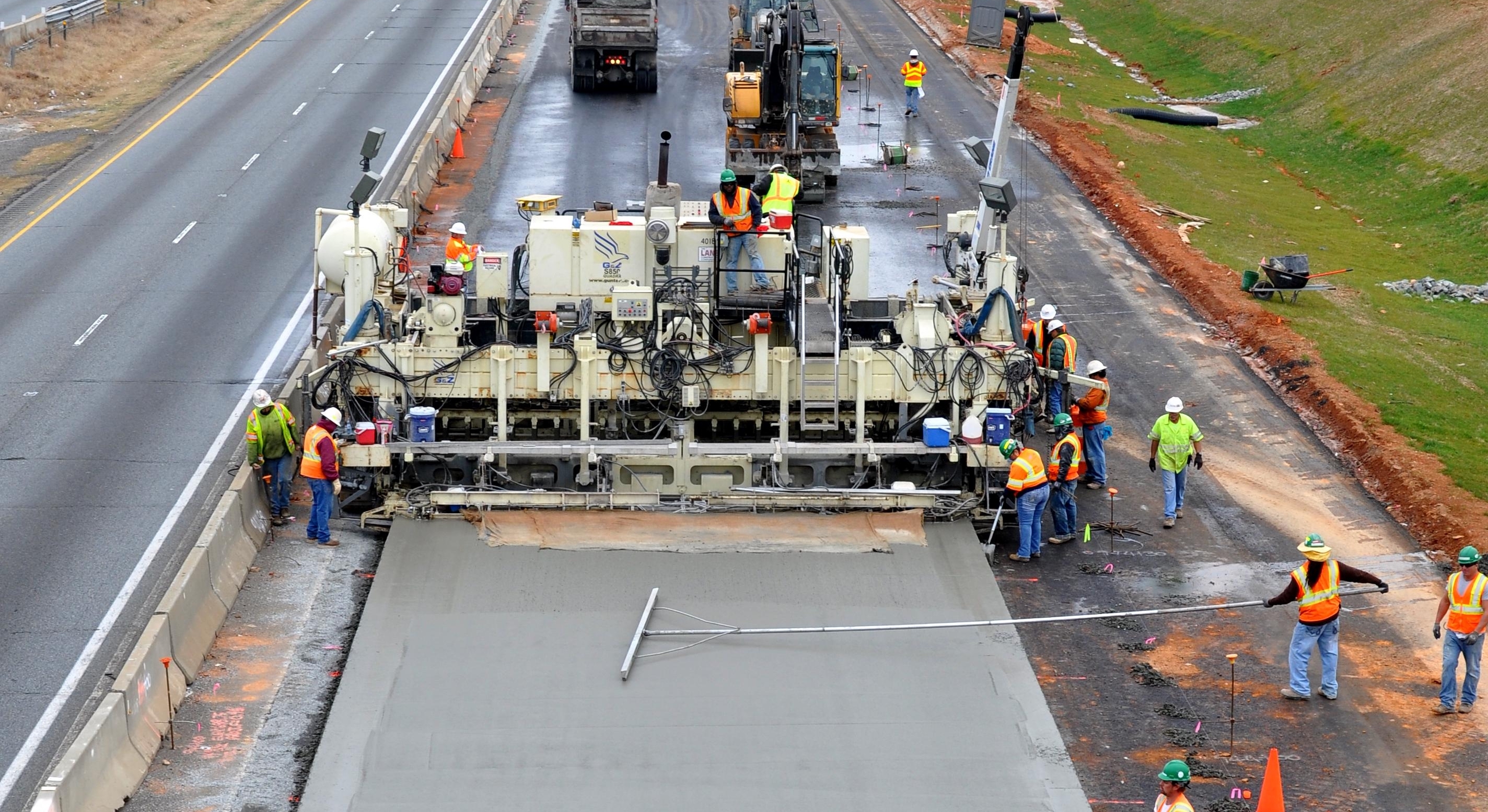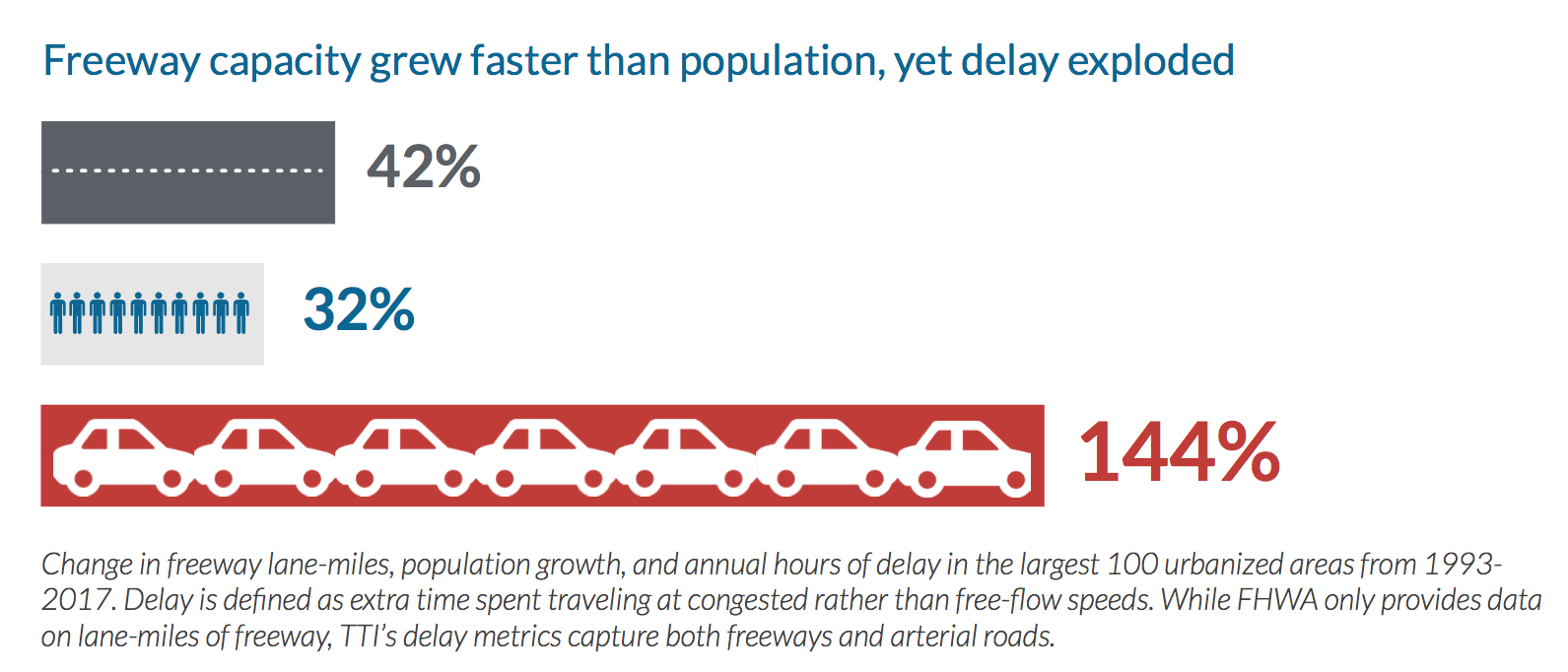The Congestion Con: You’ve been played
In a new report, The Congestion Con: How more lanes and more money equals more traffic, we show how our approach to curbing congestion with new and wider highways has failed. We have spent decades and hundreds of billions of dollars on highways in the name of beating back congestion, yet in all of the 100 most populous urbanized areas examined in the report, congestion has gotten worse as a result. The Congestion Con lays out a comprehensive look at congestion data, why our “solution” has failed, and what the federal government can do to correct course.
 Widening I-85 from four lanes to eight lanes. (Image: NCDOT, Flickr)
Widening I-85 from four lanes to eight lanes. (Image: NCDOT, Flickr)
In an expensive effort to curb congestion in urban regions, the U.S. has overwhelmingly prioritized one strategy: widening and building new highways. We added 30,511 new freeway lane-miles of road in the largest 100 urbanized areas between 1993 and 2017, an increase of 42 percent. That rate of road expansion significantly outstripped the 32 percent growth in population in those regions over the same time period.
Yet this strategy has utterly failed to “solve” congestion as our new report—The Congestion Con—makes abundantly clear.
All those new lane-miles haven’t come cheap. States alone spent more than $500 billion on highway capital investments in urbanized areas between 1993-2017, with a sizeable portion going to highway expansions. And the initial construction costs are just the tip of the iceberg. For roads that are already in good condition, it still costs approximately $24,000 per year on average to maintain each lane-mile in a state of good repair, creating significant financial liabilities now and for years into the future.
We are spending billions to widen roads and seeing unimpressive, unpredictable results in return. In those 100 urbanized areas, congestion has grown by a staggering 144 percent, far outpacing population growth. Further, the urbanized areas expanding their roads more rapidly aren’t necessarily having more success curbing congestion—in fact, in many cases the opposite is true.

Why aren’t we reducing congestion?
First, the average person drives significantly more each year in these 100 urbanized areas. Vehicle-miles traveled (VMT) per person increased by 20 percent between 1993-2017. This increase in driving is partially due to how we have allowed these urbanized areas to grow: letting development sprawl, creating greater distance between housing and other destinations, and forcing people to take longer and longer trips on a handful of regional highways to fulfill daily needs. We should be addressing those sources of congestion, but instead, we accept more driving and more traffic as unavoidable outcomes that we must address through costly highway expansion. This is a significantly more expensive and less effective approach than reducing the need to drive or length of trips. And unfortunately, spending billions to expand highways can actually make congestion worse by encouraging people to drive more than they otherwise would, a counterintuitive but well-documented phenomenon known as induced demand.
Eliminating congestion is also simply the wrong goal. While severe congestion can have real negative impacts, congestion is also generally a symptom of a successful, vibrant economy—a sign of a place people want to be. Instead, we should be focused on providing and improving access.
The core purpose of transportation infrastructure is to provide access to work, education, healthcare, groceries, recreation, and all other daily needs. Congestion can become a problem when it seriously obstructs access, but may not be a major problem if it doesn’t. Car speeds—the main proxy measure for congestion—don’t necessarily tell us anything about whether or not the transportation network is succeeding at connecting people to the things they need, as efficiently as possible. Yet a narrow emphasis on vehicle speed and delay underlies all of the regulations, procedures, and cultural norms behind transportation decisions, from the standards engineers use to design roads to the criteria states use to prioritize projects for funding. This leads us to widen freeways reflexively, almost on autopilot, perpetuating the cycle that produces yet more traffic
What needs to happen: Five policy recommendations
We need to face the music: we are doubling and tripling down on a failed strategy. We cannot keep relying on the same expensive and ineffective approach. With discussions underway about the next federal transportation legislation—a process that only happens every five years—now is the critical time to make changes before we pour billions more into a solution that doesn’t work. This report recommends five key policy changes, many of which could be incorporated into the upcoming transportation reauthorization:
1) Reorient our national program around access—connect people to jobs and services instead of focusing narrowly on speed and delay.
2) Require that transportation agencies stop favoring new roads over maintenance.
3) Make short trips walkable by making them safe. Roads surrounded by development should be designed for speeds of 35 mph or under to create safer conditions for walking and biking.
4) Remove restrictions on pricing and allow DOTs to manage congestion.
5) Reward infill development and make it easier for localities. Stop rewarding sprawl with public highway investments and instead reward localities that seek more efficient ways of moving and connecting people.
Download the full report and join the conversation online using #CongestionCon.




















Pingback: Transportation For America What would a Green New Deal for transportation look like? - Transportation For America
Pingback: What would a Green New Deal for transportation look like? | Public Transit Blog